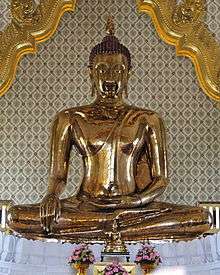Buddharupa
| Part of a series on |
| Buddhism |
|---|
 |
|
.jpg)


Buddharūpa (literally, "Form of the Awakened One") is the Sanskrit and Pali term used in Buddhism for statues or models of beings who have obtained buddhahood, including the historical Buddha.
Commonalities
Despite cultural and regional differences in the interpretations of texts about the life of Gautama Buddha, there are some general guidelines to the attributes of a Buddharupa:
- Fingers and toes are elongated proportionately
- Long, aquiline nose
- Elongated earlobes
- Head protuberance
- Broad shoulders
The elongated earlobes are vestiges of his life as a prince, when he wore extravagant jewelry. The bump at the top of the head is the ushnisha and represents spirituality, wisdom, and awakening.[1]
Regional variations
Depictions of the Buddha vary widely across cultures.
Proportions
The image of Buddhas started to emerge from the first century CE in North India, developed in Gandhara and Mathura. The art of Gandhara was influenced by Ancient Greek art, leading to the development of Greco-Buddhist art with anatomically well-proportioned and realistic figure of the Buddha. One of the most influential Buddhist art was Gupta art and the later Amaravati style. From India the depiction of Buddha spread to the rest of Asia. The Buddharupas of India, Sri Lanka, Javanese Sailendra and Cambodian art usually depict a well-proportioned figure, but sometimes he is shown emaciated, in recollection of the Buddha's years of ascetic practices. Japanese buddharupas are often very square and stolid while Indian and Southeast Asian ones often have thinner figures.
Many people may be familiar with the "Happy" or "Laughing" Buddha, a different historical figure, who should not be confused with the images of Gautama Buddha. Budai, a Chinese Buddhist monk also known as Hotei, is depicted as fat and happy, almost always shown smiling or laughing, and is associated with Maitreya, the future Buddha.
Postures, gestures and artefacts
Images of Buddha sometimes show him reclining, recalling the Buddha Shakyamuni's departure into final nirvana.
Other times he is holding various symbolic objects, or making symbolic mudras (gestures).
The clothing also varies; in China and Japan, where it is considered socially improper for monks and nuns to expose the upper arm, the Buddharupa has a tunic and long sleeves, much like the traditional monks and nuns, while in India they are often topless.
See also
References
- ↑ Victoria and Albert Museum. "Iconography of the Buddha". Retrieved 18 February 2014.
Further reading
- Nirmal C. Sinha, Buddharupa observation of the evolution of the Buddha image, Bulletin of Tibetology, Vol. 1-3, pp. 18–22
External links
| Wikimedia Commons has media related to Statues of the Buddha. |
- "Thai birth day colors and Buddha image". United States Muay Thai Association Inc. 16 October 2004. Retrieved 6 April 2011.
An innovation of the Ayutthaya period.
- "Borobudur Buddha head". BBC. Retrieved 2 August 2014.
A History of The World, The British Museum
- Bala Mudaly, Reflections inspired by the Buddha Rupa